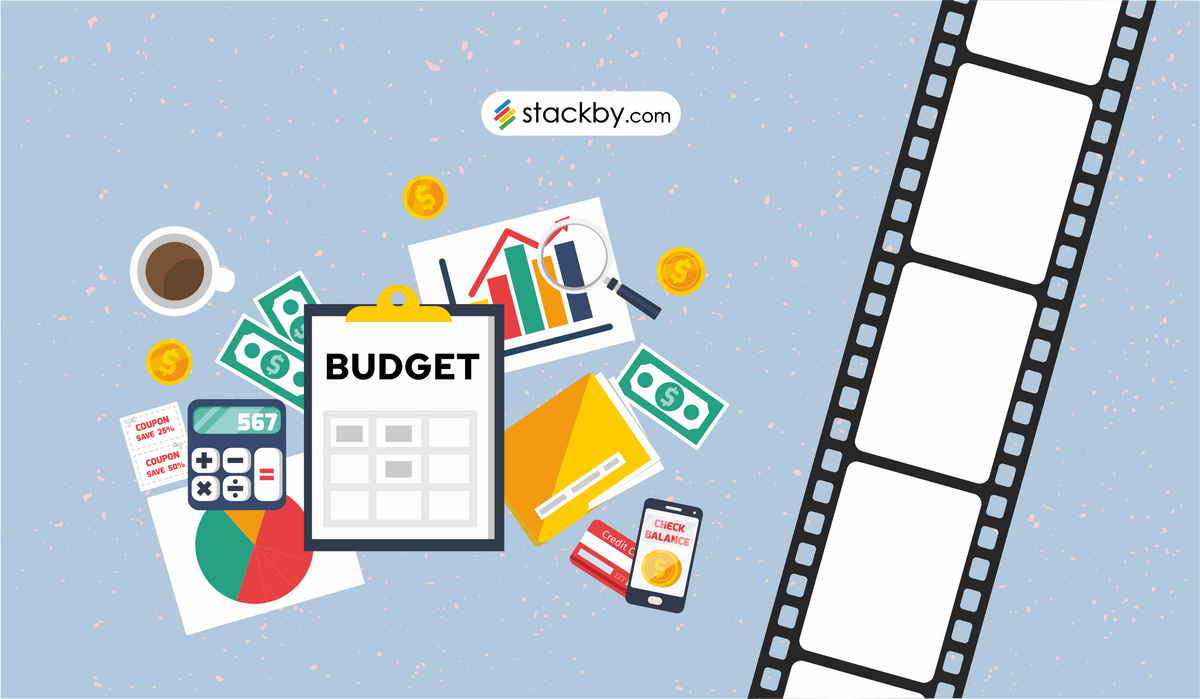Quick Guide on How to Budget a Film
Here’s a quick guide on how to budget a film. Do not forget to check our free template in the end for film budgeting breakdown.

Not all of us think about the behind-the-scenes of filmmaking. For many of us, it is a world full of the limelight, fancy cars, and million-dollar contracts. But, have you ever thought about cash flow? How do they manage money matters while creating a film? If you are thinking of a career as a film producer you must know how to budget a film. Whether you’re an indie filmmaker, a content creator or a movie production team, keep reading on.
There are many paid tools available in the market offering you complicated features at a price. But, here at Stackby, we have created a free film budget template that will help you manage all the cash flows easily.
What is Film Budgeting?
When a producer or a filmmaker has an idea for a film, the first thing that they do is create a budget or an estimation of how much it will cost to create that film. It includes all the potential costs whether it is hiring the actors, buying equipment, paying the crew members, rents and or dealing with emergencies.
Film budgeting generally occurs in two phases.
- The preliminary budget: This is a formal summary of the budget that includes all the major items. This budget is created to gain funding from a third party.
A preliminary film budget includes the following categories:
- Above the line: It includes all the development-related expenses such as the cost of hiring a director, producers, writers, and principal actors.
- Below the line: It includes pre-production and filming costs like equipment, crew, locations, permits, and vehicles.
- Below the line post: It includes the post-production costs of creating a film such as editing, visual effects, and distribution.
- Other: It includes the other costs associated with film production like insurance, marketing, etc.
- The second film budget: This budget is created once the financing is achieved. It includes the final costs that will be involved in film making such as crew costs, cast costs, vendors, and other expenses.
Why Track Film Budget?
Before we dive into how to budget a film, you must know why you need to create and track a film budget.
Budgeting is so critical to the filmmaking process because
- A budget helps you prepare for any upcoming expenses and have some mitigation strategies
- A documented budget can affect the potential costs of crews and actors
- A budget ensures that the creation of the film is financially possible
- Last, but not the least, a budget will help you know how much insurance premiums do you need to pay
Film Budget Breakdown
I have divided this topic into 4 categories of costs that might incur while filmmaking. This film budgeting breakdown will help you get a clear idea of what possible costs can be involved in creating a film and will make it much easier for you to create the budget. So, let’s get started.
Pre-production costs
--- What kind of film are you creating?
Are you creating a commercial, a TV series, drama, thriller, horror, documentary, etc.? There can be a whole range of themes, genres, and categories to consider and each category would require a different budget. So, first of all, you need to decide what kind of film you are creating.
— How big is your team?
A pre-production film budget would involve the costs of directors, actors, and other crew members. It would also count the number of days you will be shooting.
--- What equipment will you be using?
Film equipment can be expensive. You need to get in touch with the sound department, lighting department, videographers, and cameramen to know more about how much it would cost. You would also need office supplies like pens, paper, printers for printing scripts and call sheets, and so on.
Factors that can affect your film budget
Along with post-production costs you must add other costs in your film budget calculator that might affect your budget. These include the following:
-- Overtime hours
If you do not factor in the possible overtime hours, they can cost you a lot more than expected. This is because after 12 hours of shooting overtime hours are billed at double time. They might sound cheaper than scheduling another shoot day but they must be included in the budget.
-- Preparation days
Preparation days are the most important thing to consider if you want to know how to budget a film right. This includes costs involved in rehearsals, production design, costume design, styling the actors, dance practice, and more.
-- Pickup days
Pickup shoot is basically a minor shot that is filmed after the principal photography has ended. If you are making a high-budget film, you must keep a few days for a pickup shoot. Nowadays, even short film production schedules also include one or two pickup days.
-- Loss and damage costs
You must set aside some budget for stolen, damaged, or lost equipment. There could be issues of wardrobe damage that might incur extra costs.
Post-production costs
The most expensive phase of filmmaking has now ended. It is time to add post-production costs to your movie budgeting. These costs will depend widely on the genre of your film or whether you need any special effects. Thanks to digital technology, the process of post-production has become a lot easier. Here are a few important post-production costs to consider while creating your film budget.
-- Editing
This might be the largest cost during the post-production. You might hire an independent editor or an editing company based on your film. If yours is a high-budget film, it might take several months in editing. So make sure to discuss the costs before finalizing an editing team.
-- Assistants
Based on the scale of your production, you might need to hire assistant editors or post-production people for visual effects, colorists, etc.
-- Office
You might also need to set up your office, especially if you are new in film production. You need to hire equipment, bring your teams together and work on your film post-production.
-- Music and sound
It does not matter whether your film has a high budget or low budget, you need music and sound effects. You need to hire music composers, singers, and sound artists.
-- Distribution
The last post-production cost is the distribution cost. Generally, producers do not include distribution costs in the film budgeting breakdown. But, it would be a life-saver to include it. You must create a distribution plan beforehand and ensure that there is sufficient money to make your film reach out to the audience, whether you're planning to distribute via film festivals or OTT platforms like Netflix or Broadcast Television.
Keep an emergency fund
You need a plan to deal with emergencies like a show or when an actor backs out at the last moment and you have to bear the expenses. You must have a backup plan that can save you from losing all the money that you have put in the post-production and production stages.
Sometimes nature can also be a hurdle in the shooting. If you are shooting outside, make sure to check the local weather and make sure that there are no rains, winds, or snow that day. You might also need permits to shoot at an outdoor location. Make sure that you have everything sorted out before you set up for the shoot.
Last, but not least, be prepared for power failures or equipment failures. There could be a chance that you run out of power when shooting outside or some equipment might stop working. So, make sure that there is enough backup to deal with power failure or equipment failure.
Switch to a Film Budget Software
Now comes the part that can help in smoothing out everything that we discussed above - an automated tool that can help you streamline your movie budgeting. The right answer to how to budget a film! Using software to manage your film budget would be a great choice as it will make it much easier for you to overview everything from one place. You can check the real-time status of your cash flow and can alter your budget accordingly even after you start creating.
A film budget software would make it easier for you to generate budgets, group your accounts, and help you handle fringes, caps, and penalties in case you are working on a union film project. It will also help you in case you are dealing with multiple currencies and make it easier for you to calculate the fees.
Stackby's Film Production Cash Flow Template is what I recommend to every film production team these days. This template will help you manage the budget at every stage of filmmaking that is, development, pre-production, production, post-production, and distribution.
With this template you can:
- Maintain details of each kind of expense for every stage, whether daily or hourly
- Record the account to which each expense has been charged, that is, talent, location, editorial, production, etc.
- Distribute the expense between the prep, shoot and wrap processes and calculate the total cost incurred.
- Compare and contrast the estimated final cost with the budget allocated to calculate the variance. This will help you understand if you’ve crossed the assigned budget for that stage and task.
- Keep detailed records of purchase order logs.
- Record the payee, date, and description of purchase order logs.
- Keep track of the status of each PO log whether paid/or not paid.
Hope this blog gives you a better idea of how to budget a film. Each film budget might be different. So, do not rely on a standard budget. Try to be as realistic as you can. Using a spreadsheet-like database Stackby will help you create a budget in real-time, making it much easier for you to track the expenses and cash flow. Check out our Film Production Cash Flow Template today and create your film budgeting breakdown. If you haven’t yet signed up for Stackby, signup now for free.
Discover: Film Production Planning Template
Frequently Asked Questions
1. What is a good budget for a film?
A good budget for a film budget including production and distribution costs is around $100 million. The average cost to produce a major studio movie is around $65 million and the distribution costs are around $35 million.
2. What is the budget for a low-budget film?
Most production members agree that any film with a budget of below $5 million can be called a low-budget film. However, the budget cannot decide the success or failure of a film.
3. Which tool should I use for movie budgeting?
Stackby’s Film Production Cash Flow Template is the best tool for creating a film budgeting breakdown. You can customize this template to keep track of development, pre-production, production, post-production, and distribution costs.

![A Simple Guide on Workflow Management Software [Updated 2025]](/blog/content/images/size/w960/2021/12/work-management-blog.png)


